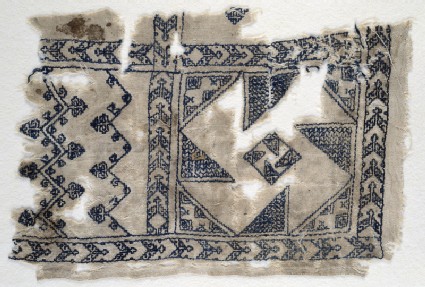Embroideries and Samplers from Islamic Egypt
A selection of 10th to 16th century embroideries from the Newberry collection at the Ashmolean by Marianne Ellis (published Oxford, 2001).

Publications online: 66 objects
- Reference URL
Actions
Textile fragment with geometric patterns
-
Literature notes
This embroidery is all worked in the double running stitch that became so fashionable for decorating both garments and household linen in 16th century Europe. The pattern with zigzag lines supporting little pendants is interesting because it is so like two published in early German pattern books, where acorn or bud motifs have been substituted for the Mamluk trefoils in one example and crosses in another to suit European taste. The other pattern based on zigzags within vertical and horizontal borders is similar to one on band sampler No.28 [EA1984.488], but instead of a continuous line of zigzags just one element has been repeated, giving quite a different visual effect.
Double running is usually classified now as an outline stitch, and one of its many modern names is two-sided line. However on this fragment it has been used both for outlines and also as a filling stitch to cover the background triangles with dense geometric patterns. This has the effect of throwing the two whirling rosettes into relief and creating a feeling of movement. This small fragment demonstrates the exceptional ability of the designers of the period to create stunning geometric patterns. -
Details
- Associated place
-
Near East (place of creation)
- Date
-
15th century (1401 - 1500)
Mamluk Period (1250 - 1517)
- Material and technique
- linen, embroidered with blue thread, possibly cotton
- Dimensions
-
29 x 20 cm max. (warp x weft)
19 / 19 threads/cm (thread count)
ground fabric 0.05 cm (thread diameter)
additional fibre, embroidery 0.06 cm (thread diameter)
- Material index
- Technique index
-
assembled › woven › plain woven,woven › plain woven,
- Object type index
- No. of items
- 1
- Credit line
- Presented by Professor Percy Newberry, 1941.
- Accession no.
- EA1984.556
-
Further reading
Ellis, Marianne, Embroideries and Samplers from Islamic Egypt (Oxford: Ashmolean Museum, in association with Greenville: Curious Works Press, 2001), no. 29 on p. 46, illus. p. 47
Barnes, Ruth and Marianne Ellis, ‘The Newberry Collection of Islamic Embroideries’, 4 vols, 2001, Oxford, Ashmolean Museum, cat. vol. iii, illus. vol. i
Location
-
- currently in research collection
Objects are sometimes moved to a different location. Our object location data is usually updated on a monthly basis. Contact the Jameel Study Centre if you are planning to visit the museum to see a particular object on display, or would like to arrange an appointment to see an object in our reserve collections.
Publications online
-

Embroideries and Samplers from Islamic Egypt
This embroidery is all worked in the double running stitch that became so fashionable for decorating both garments and household linen in 16th century Europe. The pattern with zigzag lines supporting little pendants is interesting because it is so like two published in early German pattern books, where acorn or bud motifs have been substituted for the Mamluk trefoils in one example and crosses in another to suit European taste. The other pattern based on zigzags within vertical and horizontal borders is similar to one on band sampler No.28 [EA1984.488], but instead of a continuous line of zigzags just one element has been repeated, giving quite a different visual effect.
Double running is usually classified now as an outline stitch, and one of its many modern names is two-sided line. However on this fragment it has been used both for outlines and also as a filling stitch to cover the background triangles with dense geometric patterns. This has the effect of throwing the two whirling rosettes into relief and creating a feeling of movement. This small fragment demonstrates the exceptional ability of the designers of the period to create stunning geometric patterns. -

The Newberry Collection of Islamic Embroideries
Bands with single rows of chevrons intersect to define two squares, with possibly further squares originally to follow. The chevrons are similar to those of EA1984.554. One of the squares has two rows of larger chevrons, one of which has a double outline; both have trefoil finials. The second square is filled with a large four-armed spiral with a small identical spiral at its centre. The background is embroidered in very small blue chevron lines.
The textile has a selvedge.
Notice
Object information may not accurately reflect the actual contents of the original publication, since our online objects contain current information held in our collections database. Click on 'buy this publication' to purchase printed versions of our online publications, where available, or contact the Jameel Study Centre to arrange access to books on our collections that are now out of print.
© 2013 University of Oxford - Ashmolean Museum

